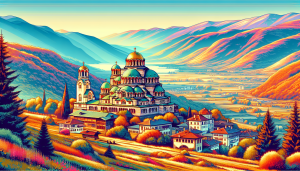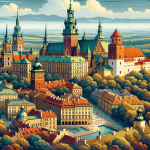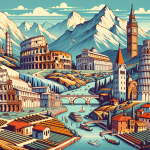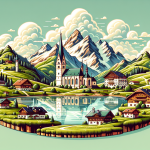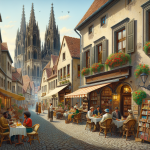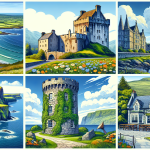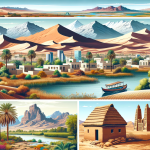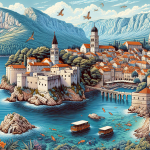Discover the Enigmatic Charm of Bulgaria: A Hidden Gem in Eastern Europe
Bulgaria, a country often overlooked by travelers, is a hidden gem nestled in the Balkans of Eastern Europe. With its rich history, vibrant culture, stunning landscapes, and warm hospitality, Bulgaria offers an array of experiences for every type of traveler. From the golden beaches of the Black Sea to the snow-capped peaks of the Rila Mountains, Bulgaria is a land of diverse beauty and contrasts. Its ancient ruins, medieval monasteries, and quaint villages take visitors on a journey through time, while its bustling cities and thriving nightlife offer modern-day excitement. The culinary delights, local wines, and traditional festivals add to the allure, making Bulgaria a must-visit destination. In this comprehensive guide, we will explore the multifaceted attractions of Bulgaria, diving into its historical treasures, natural wonders, and cultural highlights, providing you with all the information you need to plan an unforgettable trip to this fascinating country.
Unraveling the Historical Wonders of Bulgaria
Sofia: The Capital with a Rich Heritage
Sofia, the capital city of Bulgaria, is a treasure trove of historical and cultural landmarks. As one of Europe’s oldest cities, Sofia boasts a blend of ancient and modern attractions that reflect its long and varied past. Alexander Nevsky Cathedral is one of Sofia’s most iconic landmarks, known for its impressive size and stunning Neo-Byzantine architecture. The cathedral serves as a symbol of Bulgaria’s Orthodox Christian heritage. For those interested in ancient history, the Serdica Archaeological Complex offers a glimpse into the Roman era, with well-preserved ruins of Roman streets, houses, and public buildings.
The National Museum of History in Sofia is another must-visit, housing an extensive collection of artifacts from Bulgaria’s prehistoric times to the present day. The museum’s exhibits provide a comprehensive overview of the country’s rich history and cultural heritage. Additionally, the Boyana Church, a UNESCO World Heritage Site, is renowned for its medieval frescoes that are considered masterpieces of Eastern European medieval art.
Plovdiv: Europe’s Oldest Continuously Inhabited City
Plovdiv, often referred to as the cultural capital of Bulgaria, is one of the oldest continuously inhabited cities in Europe. The city’s historic quarter, known as the Old Town, is a maze of cobblestone streets, colorful houses, and ancient ruins. The Ancient Theatre of Philippopolis, a well-preserved Roman amphitheater, is a highlight of Plovdiv and still hosts performances today, offering a unique experience of blending history with contemporary culture.
The Roman Stadium, another significant archaeological site, once accommodated up to 30,000 spectators for sporting events. The Ethnographic Museum in Plovdiv provides insights into traditional Bulgarian life, showcasing folk costumes, crafts, and household items. Visitors can also explore the vibrant Kapana District, known for its artistic vibe, trendy cafes, and lively atmosphere.
Veliko Tarnovo: The Medieval Capital
Veliko Tarnovo, the medieval capital of Bulgaria, is a city steeped in history and tradition. The Tsarevets Fortress is the crown jewel of Veliko Tarnovo, perched on a hill overlooking the Yantra River. The fortress served as the primary residence of Bulgarian tsars during the Second Bulgarian Empire and offers panoramic views of the city and surrounding landscapes. The Arbanasi Village, located nearby, is known for its well-preserved traditional houses and churches, providing a glimpse into Bulgaria’s past.
The Asen’s Monument, dedicated to the Asen dynasty, is another notable landmark in Veliko Tarnovo, offering a striking view of the city. The Samovodska Charshia, a historic market street, is a great place to explore local crafts and traditional Bulgarian products.
Exploring Bulgaria’s Natural Beauty
The Rila Mountains and Rila Monastery
The Rila Mountains, part of the Balkan Mountain Range, are a paradise for nature lovers and outdoor enthusiasts. The Rila National Park is home to Bulgaria’s highest peak, Mount Musala, which stands at 2,925 meters. The park offers numerous hiking trails, alpine meadows, and glacial lakes, making it an ideal destination for trekking and nature photography.
Nestled within the Rila Mountains is the Rila Monastery, Bulgaria’s most famous and largest monastery. The Rila Monastery, a UNESCO World Heritage Site, is renowned for its stunning architecture, frescoes, and historical significance. Founded in the 10th century by St. John of Rila, the monastery has been a spiritual and cultural center for centuries. Visitors can explore the monastery’s church, museum, and surrounding natural beauty.
The Rose Valley and Kazanlak
The Rose Valley, located near the town of Kazanlak, is famous for its rose fields and the production of rose oil, often referred to as “liquid gold.” The valley comes alive in May and June during the Rose Festival, a celebration of the rose harvest that includes traditional music, dance, and the crowning of the Rose Queen. Visitors can learn about the rose oil production process at the Rose Museum and even participate in rose-picking activities.
Kazanlak is also home to the Thracian Tomb of Kazanlak, another UNESCO World Heritage Site. The tomb, dating back to the 4th century BC, is known for its well-preserved murals depicting Thracian culture and rituals.
The Rhodope Mountains and Devil’s Throat Cave
The Rhodope Mountains, with their lush forests and picturesque villages, offer a serene escape from the hustle and bustle of city life. The Devil’s Throat Cave, one of the most famous caves in the Rhodopes, is shrouded in legend and mystery. The cave’s main chamber is one of the largest in Europe, and the underground river that flows through it creates a dramatic waterfall. According to local legend, the ancient Greek hero Orpheus descended into the underworld through this cave in search of his beloved Eurydice.
Yagodina Cave, another notable cave in the Rhodope Mountains, is known for its impressive stalactites and stalagmites. Visitors can take guided tours to explore the cave’s natural formations and learn about its geological history.
Experiencing Bulgaria’s Cultural Richness
Bulgarian Cuisine: A Culinary Journey
Bulgarian cuisine is a delightful blend of flavors and influences from the Balkans, the Mediterranean, and the Middle East. Traditional dishes often feature fresh vegetables, dairy products, and meats, with an emphasis on seasonal and locally-sourced ingredients. Banitsa, a savory pastry made with layers of filo dough, cheese, and eggs, is a popular breakfast item. Shopska Salad, made with tomatoes, cucumbers, peppers, onions, and feta cheese, is a refreshing and colorful dish that represents the colors of the Bulgarian flag.
Kebapche, grilled minced meat sausages, and Kavarma, a slow-cooked meat and vegetable stew, are other traditional favorites. Bulgarian yogurt, known for its unique taste and probiotic properties, is a staple in many dishes and desserts. The local wines and rakia, a fruit brandy, complement the culinary experience, offering a taste of Bulgaria’s viticultural heritage.
Traditional Festivals and Folklore
Bulgaria’s rich cultural heritage is celebrated through numerous festivals and traditions throughout the year. The Kukeri Festival, held in various regions, is a unique and colorful event where participants dress in elaborate costumes and masks to ward off evil spirits and bring good fortune. The Nestinari Firewalking Festival in the village of Bulgari is another fascinating tradition, where barefoot dancers perform on hot embers as part of a ritual honoring St. Constantine and St. Helena.
The Surva Festival in Pernik is one of the largest and oldest mask festivals in Europe, attracting participants and visitors from around the world. The festival features traditional rituals, music, dance, and a parade of elaborately costumed performers.
Bulgaria’s Coastal Charms
The Black Sea Coast
Bulgaria’s Black Sea coast offers a mix of golden beaches, historic towns, and vibrant seaside resorts. The city of Varna, often referred to as the “Sea Capital” of Bulgaria, is a popular destination with its beautiful beaches, lively nightlife, and rich cultural heritage. The Varna Archaeological Museum houses the world’s oldest gold treasure, dating back to 4,600-4,200 BC.
Burgas, another major coastal city, is known for its beautiful sea gardens, sandy beaches, and the annual Sand Festival, where artists create intricate sand sculptures. The nearby Nessebar, a UNESCO World Heritage Site, is a charming ancient town with well-preserved medieval and Byzantine architecture.
Sunny Beach and Sozopol
Sunny Beach, located near Nessebar, is one of Bulgaria’s most famous seaside resorts, known for its lively atmosphere, water sports, and vibrant nightlife. The resort offers a wide range of accommodations, dining options, and entertainment, making it a popular choice for both families and young travelers.
Sozopol, on the other hand, offers a more relaxed and historic experience. The town’s Old Town is characterized by narrow streets, wooden houses, and ancient ruins. The Sozopol Archaeological Museum showcases artifacts from the town’s long history, dating back to ancient Greek and Thracian times. The Apollonia Festival of Arts, held annually in Sozopol, is a cultural highlight, featuring music, theater, dance, and visual arts performances.
Practical Tips for Traveling in Bulgaria
Getting Around
Bulgaria has a well-developed transportation network, making it easy to travel between cities and regions. Trains and buses are the most common modes of public transportation, with regular services connecting major cities and towns. Car rentals are also available for those who prefer the flexibility of driving, and the country’s roads are generally well-maintained.
Language and Communication
While Bulgarian is the official language, English is widely spoken in tourist areas, hotels, and restaurants. Learning a few basic Bulgarian phrases can enhance your travel experience and help you connect with locals.
Currency and Payments
The official currency of Bulgaria is the Bulgarian Lev (BGN). Credit and debit cards are widely accepted in cities and tourist areas, but it’s advisable to carry some cash for smaller towns and rural areas. ATMs are readily available in urban areas.
Safety and Health
Bulgaria is generally a safe destination for travelers, with low crime rates and a welcoming atmosphere. It’s always a good idea to take standard precautions, such as safeguarding personal belongings and avoiding poorly lit areas at night. Tap water is safe to drink in most places, but bottled water is also readily available.
Conclusion
Bulgaria is a captivating destination that offers a unique blend of history, culture, natural beauty, and modern amenities. Whether you’re exploring ancient ruins, hiking in the mountains, lounging on the beach, or indulging in delicious cuisine, Bulgaria has something for everyone. Its rich heritage, warm hospitality, and diverse attractions make it a must-visit country in Eastern Europe. So pack your bags, and get ready to discover the enigmatic charm of Bulgaria – a hidden gem waiting to be explored.
For more information on traveling to Bulgaria, visit the official Bulgaria tourism website.
